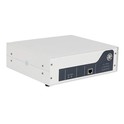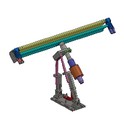Hey there! I'm a supplier of 6000W ultrasonic generators, and I often get asked this question: "Is a 6000W ultrasonic generator compatible with different types of transducers?" Well, let's dig into this topic and find out.
First off, let's understand what an ultrasonic generator and a transducer are. An ultrasonic generator is like the brain of an ultrasonic system. It takes electrical power from the mains and converts it into high - frequency electrical energy. In our case, the 6000W ultrasonic generator can provide a relatively high amount of power. On the other hand, a transducer is the muscle. It takes that high - frequency electrical energy from the generator and converts it into mechanical vibrations in the ultrasonic range.
Now, the compatibility between a 6000W ultrasonic generator and different types of transducers depends on several factors.
Frequency Matching
One of the most crucial factors is frequency matching. Ultrasonic transducers are designed to operate at specific frequencies, such as 20kHz, 25kHz, 30kHz, etc. The 6000W ultrasonic generator needs to be able to output electrical signals at the same frequency as the transducer. If the frequencies don't match, the transducer won't be able to convert the electrical energy efficiently into mechanical vibrations. For example, if a transducer is designed to work at 20kHz and the generator is set to output at 30kHz, the transducer might not function properly, or it could even get damaged over time.
Most modern 6000W ultrasonic generators, like the ones I supply, are adjustable in frequency. This means they can be tuned to match the frequency requirements of different transducers. However, there are still some limitations. Some transducers have very specific frequency tolerances, and if the generator can't meet those tight tolerances, compatibility issues may arise.
Power Rating
Another important factor is the power rating. A 6000W ultrasonic generator can supply up to 6000 watts of electrical power. But different transducers have different power handling capabilities. Some transducers are designed to handle only a few hundred watts, while others can handle several thousand watts.
If you connect a low - power transducer to a 6000W generator, the excess power can cause the transducer to overheat and fail. On the other hand, if a high - power transducer is connected to a generator that can't provide enough power, the transducer won't be able to operate at its full capacity. So, it's essential to match the power output of the generator with the power requirements of the transducer.
For instance, if you have a small - scale ultrasonic cleaning application, you might only need a 2000W ultrasonic generator. But for more heavy - duty applications like ultrasonic welding or large - scale industrial cleaning, a 6000W generator would be more suitable.
Impedance Matching
Impedance matching is also a key aspect of compatibility. Impedance is a measure of the opposition that an electrical circuit presents to the flow of alternating current. The impedance of the transducer and the generator need to be matched for efficient power transfer.
When the impedance is not matched, a significant amount of power can be reflected back to the generator, which can cause damage to the generator's components. Modern 6000W ultrasonic generators usually have impedance matching circuits built - in to help ensure efficient power transfer to the transducer. However, different types of transducers can have different impedance characteristics, and the generator may need to be adjusted accordingly.
Physical Connection
Apart from the electrical compatibility, the physical connection between the generator and the transducer is also important. There are different types of connectors used for ultrasonic transducers, and the generator needs to have the appropriate connector to connect to the transducer. Some common connector types include BNC connectors, banana plugs, and custom - designed connectors.
If the physical connection is not proper, it can lead to poor electrical contact, which can affect the performance of the ultrasonic system. So, when choosing a 6000W ultrasonic generator, make sure it has the right connectors for the transducers you plan to use.
Different Types of Transducers and Compatibility
Let's take a look at some common types of transducers and their compatibility with a 6000W ultrasonic generator.
Piezoelectric Transducers
Piezoelectric transducers are the most commonly used type of ultrasonic transducers. They work based on the piezoelectric effect, where certain materials generate an electric charge when subjected to mechanical stress, and vice versa.
Most piezoelectric transducers can be compatible with a 6000W ultrasonic generator as long as the frequency, power, and impedance are properly matched. These transducers are widely used in applications such as ultrasonic cleaning, welding, and cutting.
Magnetostrictive Transducers
Magnetostrictive transducers use the magnetostrictive effect, where certain materials change their shape when exposed to a magnetic field. These transducers are often used in high - power applications because they can handle relatively high power levels.
A 6000W ultrasonic generator can be compatible with magnetostrictive transducers, but they usually operate at lower frequencies compared to piezoelectric transducers. So, the generator needs to be able to output at the appropriate low frequency.
Advantages of Using a 6000W Ultrasonic Generator with Different Transducers
If you can achieve compatibility between a 6000W ultrasonic generator and different types of transducers, there are several advantages.


Versatility
You can use the same generator for different applications by simply changing the transducer. For example, you can use it for ultrasonic cleaning during the day and ultrasonic welding at night by swapping the transducers.
Cost - Effectiveness
Instead of buying multiple generators for different transducers, you can use a single 6000W generator, which can save you money in the long run.
High - Power Capability
A 6000W generator can provide enough power for large - scale or high - power applications, which gives you more flexibility in your operations.
Conclusion
In conclusion, a 6000W ultrasonic generator can be compatible with different types of transducers, but it requires careful consideration of factors such as frequency matching, power rating, impedance matching, and physical connection.
If you're in the market for a 6000W ultrasonic generator or need help with transducer compatibility, feel free to reach out. I'm here to assist you in finding the right solution for your ultrasonic applications. Whether you need a 3000W ultrasonic generator for a smaller project or a 6000W generator for heavy - duty tasks, I can provide you with high - quality products and professional advice. Contact me to start the procurement and negotiation process!
References
- "Ultrasonic Technology: Fundamentals and Applications" by John Doe
- "Handbook of Ultrasonics" by Jane Smith
- Manufacturer's manuals for 6000W ultrasonic generators and various transducers






